Accepted Scientific Name: Conophytum globosum (N.E.Br.) N.E.Br.
Gard. Chron. III, 71: 231 1922.
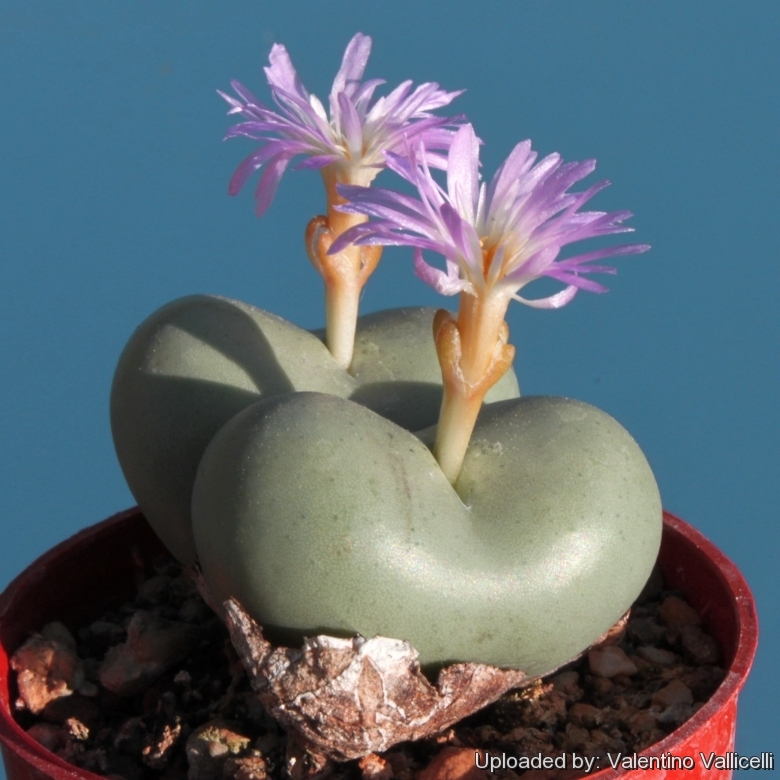
Conophytum globosum var. vanbredae Photo by: Valentino Vallicelli
RR1062 Loerkop, ex Rawe
Origin and Habitat: Namaqualand, Northern Cape, South Africa.
Altitude: 300-580 metres above sea level.
Habitat: It grows on granite outcrops.
Synonyms:
See all synonyms of Conophytum globosum
back
Accepted name in llifle Database:Conophytum globosum (N.E.Br.) N.E.Br.Gard. Chron. III, 71: 231 1922.Synonymy: 7
back
Description: Conophytum globosumSN|21939]]SN|18962]] is a dwarf compact ground-cover succulent with delicate white flowers touched with pink. It has nearly globose pale green bodies suggesting the epithet. Conophytum globosumSN|17466]]SN|18962]] is surely connected with the Conophytum minutumSN|17466]]SN|17466]] complex, particularly with Conophytum minutumSN|18962]]SN|17466]] var. pearsonii, which can be confused with it. Some of the southern forms are so much flattened that they resemble Conophytum wettsteiniiSN|18962]]SN|21939]].
Habit: Caespitose, forming a tight cushion.
Stem: Stemless or with very short stems with time.
Bodies (Paired leaves): Up to 20 mm large, 15 mm tall, kidney-shaped, globose to turbiniform, shining pale green, usually unspotted, always glabrous, never marked with red. During the summer season, plants aestivate and the body is gradually replaced by a new young pair of leaves.
Flowers: Petals pink to white or rarely salmon, golden filamentous staminodes always present.
Blooming season: The flowers are autumnal.
Fruit: Hygrochastic 4-5-locular capsules, that usually remain on the plant, but strong winds can dislodge and blow them over considerable distances.
Subspecies, varieties, forms and cultivars of plants belonging to the Conophytum globosum group
Notes: Plants of the genus Conophytum are also known as "living pebbles". During the rest period (the summer months in Europe) a new body forms inside the old, gradually taking all the substances from it until all that remains is the skin, which dries and protects the young plant from the heat of the sun and excess evaporation of water. The resting Conophytum protected by this dry cover resembles a pebble and hence the name "living pebble". The growth period of most species is from August to March. The temperature should be about 10 to 12°C.
Bibliography: Major references and further lectures
1) James Cullen, Sabina G. Knees, H. Suzanne Cubey “The European Garden Flora Flowering Plants: A Manual for the Identification of Plants Cultivated in Europe, Both Out-of-Doors” Cambridge University Press, 11/Aug./2011
3) Hammer, S. 1993. “The Genus Conophytum - A Conograph.” Succulent Plant Publications, Pretoria.
4) Raimondo, D., von Staden, L., Foden, W., Victor, J.E., Helme, N.A., Turner, R.C., Kamundi, D.A. and Manyama, P.A. 2009. “Red List of South African Plants.” Strelitzia 25. South African National Biodiversity Institute, Pretoria.
6) Hammer, S. 2002. “Dumpling and His Wife: New Views of the Genus Conophytum.” East Anglia Engraving Creative Colour Ltd, Norwich, England.
7) Vera Higgins “Succulents in Cultivation (Cacti Included)” St. Martin's Press, 1960
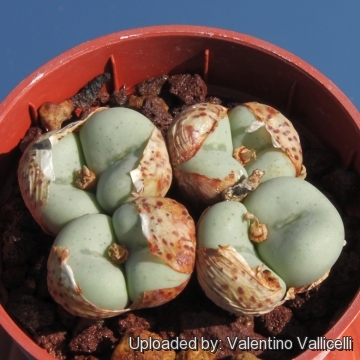 Conophytum globosum var. vanbredae Photo by: Valentino Vallicelli
Conophytum globosum var. vanbredae Photo by: Valentino Vallicelli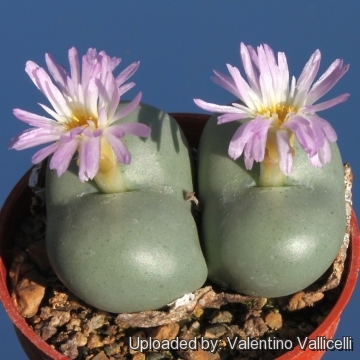 Conophytum globosum var. vanbredae Photo by: Valentino Vallicelli
Conophytum globosum var. vanbredae Photo by: Valentino Vallicelli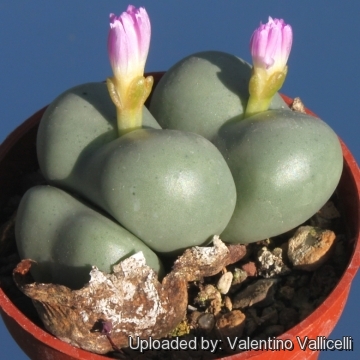 Conophytum globosum var. vanbredae Photo by: Valentino Vallicelli
Conophytum globosum var. vanbredae Photo by: Valentino Vallicelli Conophytum globosum 'vanbredai' SB1104 Loerkop, small form, varied flowers. Photo by: Valentino Vallicelli
Conophytum globosum 'vanbredai' SB1104 Loerkop, small form, varied flowers. Photo by: Valentino Vallicelli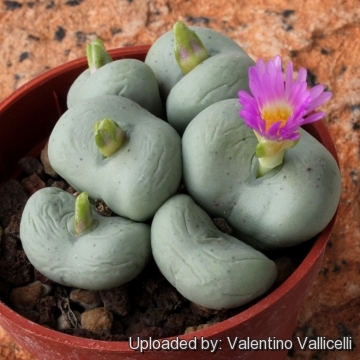 Conophytum globosum var. vanbredae Photo by: Valentino Vallicelli
Conophytum globosum var. vanbredae Photo by: Valentino Vallicelli Conophytum globosum var. vanbredae Photo by: Valentino Vallicelli
Conophytum globosum var. vanbredae Photo by: Valentino Vallicelli Conophytum globosum var. vanbredae Photo by: Valentino Vallicelli
Conophytum globosum var. vanbredae Photo by: Valentino VallicelliSend a photo of this plant.The gallery now contains thousands of pictures, however it is possible to do even more. We are, of course, seeking photos of species not yet shown in the gallery but not only that, we are also looking for better pictures than those already present.
Read More... Cultivation and Propagation: Conophytum globosumSN|18962]]SN|18962]] var. vanbredae is a "winter" grower which is most active from late winter until later spring and heading for summer dormancy, but in favourable growing conditions it keeps going over the summer too and doesn't need particular care. All the forms of Conophytum globosumSN|18962]]SN|18962]] are easy to grow.
Soil: Requires good drainage as it it is prone to root rot. It can grows outdoor in sunny, dry, rock crevices (protection against winter wet is required) It can also be cultivated in alpine house, in poor, drained soil.
Watering: It requires little water; otherwise its epidermis breaks (resulting in unsightly scars). Water minimally in summer, (only when the plant starts shrivelling), but it will generally grow even in summer if given water. Water regularly in winter after the previous year's leaves have dried up. Requires good drainage.
Fertilization: Feed it once during the growing season with a fertilizer specifically formulated for cactus succulents (poor in nitrogen), including all micro nutrients and trace elements diluted to ½ the strength recommended on the label. It thrives in poor soils and need a limited supplies of fertilizer to avoid the plants developing excess vegetation, which is easily attacked by fungal diseases.
Exposure: Keep cool and shaded in summer, it needs full sun or light shade.
Temperature: Hardy to -2°C. Ensure a very good ventilation.
Repotting: Avoid to repot frequently. This plant may stay in the same pot for many years.
Uses: Container, rock garden.
Pests and diseases: It is vulnerable to mealybugs and rarely scale.
Propagation:: It can be reproduced both by cuttings and seeds. Take the cutting from a grown-up mother plant. Each cutting must contain one or more heads along with a fraction of root. It is easily propagated by seed. The small seeds can be sown in pots of fine, well-drained sand, any time during the spring and summer months when temperatures are warm. Cover the seeds with a very fine layer of grit and water from below with a fungicide to prevent damping off. For the first 3-4 days cover the pots with a sheet of glass/clear perspex to keep the humidity levels high. Remove the glass and replace it with light shadecloth and mist once or twice a day for the next two weeks after which most seeds should have germinated. From then on mistings can be reduced to every second and then every third day as the little plants grow.


















